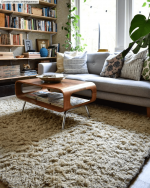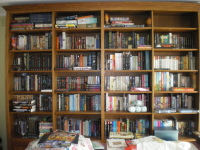I could get all first reflections down considerably by using just 3 absorbing panels with a line array. Try to do that with any conventional speaker.
Don't forget that a conventional speaker radiates it's energy much wider in a vertical plane. So which speaker is going to "spray the room" more?
As a comparison to the previous posted data in this room...
RT60 measurement, mains + ambience of a straight, unshaded straight array in a living room at listening position:

Wavelet of the Stereo pair (after DSP and room treatment):

With subwoofers, unshaded straight array, left speaker timing and right speaker timing in wavelets:
Left + sub:

Right + sub:

How many concepts do you know that can do this, in a living room with minimal treatment?
A shaded array has even less room influence. I just haven't done "the run around" again to record it into some new graphs.
There's a lot of misconception about arrays. Let me run the following by you:
You've probably done measurements, how does it look at a single spot at listening distance, what do the reflections look like? Now record an IR in several different spots, average those measurements after lining them up, what happened to the reflection peaks after the main impulse? Now think hard about a single listening spot and multiple drivers playing (each playing just a tiny part). What happens to all those reflections, as seen from that listening spot?
Don't forget that a conventional speaker radiates it's energy much wider in a vertical plane. So which speaker is going to "spray the room" more?
As a comparison to the previous posted data in this room...
RT60 measurement, mains + ambience of a straight, unshaded straight array in a living room at listening position:
Wavelet of the Stereo pair (after DSP and room treatment):
With subwoofers, unshaded straight array, left speaker timing and right speaker timing in wavelets:
Left + sub:
Right + sub:
How many concepts do you know that can do this, in a living room with minimal treatment?
A shaded array has even less room influence. I just haven't done "the run around" again to record it into some new graphs.
There's a lot of misconception about arrays. Let me run the following by you:
You've probably done measurements, how does it look at a single spot at listening distance, what do the reflections look like? Now record an IR in several different spots, average those measurements after lining them up, what happened to the reflection peaks after the main impulse? Now think hard about a single listening spot and multiple drivers playing (each playing just a tiny part). What happens to all those reflections, as seen from that listening spot?
Last edited:
So here is where I start from for the new speaker locations (echo chamber v2) 😀

Frequency responses of L& R speakers from close to listening position 2.5m away

Spectrogram+EDT

It sounds better than before though already.. 🙂
Now need to get some absorption panels.. If I am going to cover about 25% of the wall surfaces itself, there is lot of area to cover and that too in a living room.. 😀
Frequency responses of L& R speakers from close to listening position 2.5m away
Spectrogram+EDT
It sounds better than before though already.. 🙂
Now need to get some absorption panels.. If I am going to cover about 25% of the wall surfaces itself, there is lot of area to cover and that too in a living room.. 😀
That looks like a very very cozy place..Good ole bookshelf half filled with books etc. useless crap could take other sidewall...
A big woollen wall cloth (carpet?) hiding acoustic panels behind the listener...
Lamb's fur rug on the floor and a small table...
View attachment 1113727 View attachment 1113726
😍
Vineeth,
if you can, just for test, put bed mattres (or two) vertically on the wall between speakers. Two chairs left and right from speakers on first reflection spots and hang two blankets over chair rests. These can be close to the speakers, away from side walls. Also one blanket on the floor. It is quick and simple and covers large surface area. You will not believe how big is the dfference. It could happen that you change opinion on your speaker sets...
After my tests I bought another layer of curtains, thicker carpet, and TV screen was kicked out from the wall between speakers...when you make good apsorption and midrange decay, imageing is getting really razor sharp, almost unbelievable, even from midfi speakers where you would never expect something like that...
I also like in bad rooms Gerhard placement, it can give very good results, especially if you have problem with bass modes...
🙂
if you can, just for test, put bed mattres (or two) vertically on the wall between speakers. Two chairs left and right from speakers on first reflection spots and hang two blankets over chair rests. These can be close to the speakers, away from side walls. Also one blanket on the floor. It is quick and simple and covers large surface area. You will not believe how big is the dfference. It could happen that you change opinion on your speaker sets...
After my tests I bought another layer of curtains, thicker carpet, and TV screen was kicked out from the wall between speakers...when you make good apsorption and midrange decay, imageing is getting really razor sharp, almost unbelievable, even from midfi speakers where you would never expect something like that...
I also like in bad rooms Gerhard placement, it can give very good results, especially if you have problem with bass modes...
🙂
Yes TV between speakers is not ideal. A projection screen is better. But no screen is the best. But you have to make do with what you have. My current home since 2022 is northern Australia; tropical climate with temperature ranging between 22 and 34 C on any given day. Wild wet weather and risk of tropical cyclones requiring bunkers for shelter/safety.
So as much as I would love to have thick rugs, (this is really good, as Juha suggested) just looking at thick rugs my home makes me feel ill.
Just add your mix of furnishings as how you would live. Asymmetry is good.
Here's a panoramic view of my current living room in 2022.... the curtains, bookshelf and chairs really helped for the piano...

So as much as I would love to have thick rugs, (this is really good, as Juha suggested) just looking at thick rugs my home makes me feel ill.
Just add your mix of furnishings as how you would live. Asymmetry is good.
Here's a panoramic view of my current living room in 2022.... the curtains, bookshelf and chairs really helped for the piano...
Last edited:
I'm not sure, but I think that a panel tv on a stand between speakers helps to tame low freq modes. At least they don't make first refections. Sofas are always for good and wide range.Thick carpets work only at high F. Sofa table with candles, glassware etc. are diffusers. Thin curtains don't do much unless tjey are at first reflection points.
Positioning helps for first reflections and lateral lowest modes, but not decay time in general.
Acoustic panels hanging from the ceiling are effective, but impossible at rented apartments and not practical with low height rooms.
Positioning helps for first reflections and lateral lowest modes, but not decay time in general.
Acoustic panels hanging from the ceiling are effective, but impossible at rented apartments and not practical with low height rooms.
Funny thing is I dont have a TV at home.. There are 5 computers in total though.. 😀
New furniture can only be brought in after 3-4 months when a decision regarding whether we have to move from this house (been here for the last 4 years) or not.. At the moment I am mainly looking to buy 3-4 nos of (4 ft x 2 ft/6 ft x 2ft) 4-6 inch thick acoustic absorption panels (also depending upon how much my wife will allow me to keep 😀). And probably corner stand as seen in @tktran303's pic (probably wont help much with acoustics of the room in my case though). I have a stone studded wall on the left side of speakers at first reflection points and a big window with a thin curtain on the right side.. Does indoor plants help?
Below is a panoramic view of the room from listening position 🙂

New furniture can only be brought in after 3-4 months when a decision regarding whether we have to move from this house (been here for the last 4 years) or not.. At the moment I am mainly looking to buy 3-4 nos of (4 ft x 2 ft/6 ft x 2ft) 4-6 inch thick acoustic absorption panels (also depending upon how much my wife will allow me to keep 😀). And probably corner stand as seen in @tktran303's pic (probably wont help much with acoustics of the room in my case though). I have a stone studded wall on the left side of speakers at first reflection points and a big window with a thin curtain on the right side.. Does indoor plants help?
Below is a panoramic view of the room from listening position 🙂
Funny thing is I dont have a TV at home.. There are 5 computers in total though.. 😀
Hi,When you clap above your head you are placing the source closest to the most reflective boundary the ceiling, as the handclap is quite omnidirectional you hear the reflections most loudly, no surprise. When you put your hands below, there is your body, the seat and maybe the carpet blocking a number of paths so you don't hear a problem.
I don't have an issue with saying don't put omnidirectional sources high up in an untreated room, but if the source has very high vertical directivity the biggest offender is taken away or at least significantly subdued.
Most of the panels I use myself to reduce specular reflection and as broadband absorption are full height free standing, because absolutely leaving large sections of bare walls above and below a smaller panel isn't going to be as effective at combating this sort of issue.
I don't disagree with the problem, but I do with the conclusion.
PS It is how the sound radiates from the speaker that needs the effort to work out.
well, one can use logic, clap and listen to various places, make Venn diagram out of it and figure out which parallel surfaces are the most probable candidates. If it was ceiling reflection I hear it would be heard more clearly clapping further from it I think. But its so close in time that any single reflection from it doesnt hear as separate event so I dont think flutter in my place is between ceiling and floor.
I did test sitting on floor, standing up in various orientations shadowing with my body etc its front and back wall in my listening setup, that have flutter echo. Other sidewall is missing (open plan kitchen there) so this dimension doesnt flutter. Its not ceiling and floor because I cant get it to flutter (which by definition is resonance, multiple bounces backn forth) while listening / clapping below furniture level so logic is flutter happens above furniture level, between front and back wall. I haven't done any measurements so its just hand claps, ears and logic, quite rudimentary.
Well, anyone can do this test if they like and draw conclusions of it if they wish, perhaps measure the room and so on, figure out how to emply acoustic treatment if it feels something important.
Directivity will absolutely affect, for example line array would output almost nothing that would end up bouncing between ceiling and floor. Side reflections can be reduced by reducing horizontal coverage angle and using toe-in. However, there is almost nothing directivity can do to reduce flutter between front and back wall because we have to project sound towards listener. I need to negotiate if we could have some panels put up on the back/front wall. But first need to measure, waiting for quiet day to do it 🙂
Last edited:
I could get all first reflections down considerably by using just 3 absorbing panels with a line array. Try to do that with any conventional speaker.
Don't forget that a conventional speaker radiates it's energy much wider in a vertical plane. So which speaker is going to "spray the room" more?
As a comparison to the previous posted data in this room...
RT60 measurement, mains + ambience of a straight, unshaded straight array in a living room at listening position:
View attachment 1113616
Wavelet of the Stereo pair (after DSP and room treatment):
View attachment 1113617
With subwoofers, unshaded straight array, left speaker timing and right speaker timing in wavelets:
Left + sub:
View attachment 1113618
Right + sub:
View attachment 1113619
How many concepts do you know that can do this, in a living room with minimal treatment?
A shaded array has even less room influence. I just haven't done "the run around" again to record it into some new graphs.
There's a lot of misconception about arrays. Let me run the following by you:
You've probably done measurements, how does it look at a single spot at listening distance, what do the reflections look like? Now record an IR in several different spots, average those measurements after lining them up, what happened to the reflection peaks after the main impulse? Now think hard about a single listening spot and multiple drivers playing (each playing just a tiny part). What happens to all those reflections, as seen from that listening spot?
Hi wesayso,
I'm sure you have very good setup.
I havent heard line arrays at home, nor anybody else with proper hifi setup, or any room with any attention to acoustics so cannot comment 🙂 Also have no acoustics related measurements from my own setup so there is nothing I could compare to.
Hi, definitely will measure and its about the next step on my speaker journey. Speakers are close to finished and its time to find out if they work as planned with room, if they dont figure out why and so on. Its only recently I got speakers running (in stereo) and progress is slow, as free time is short supply until the family is sleeping so most of the time the hobby is reading and thinking and writing on the forum 🙂
Flutters are between parallel surfaces, but you can get slap back mixed in, it can be difficult to differentiate what is what in an auditory comparison.Hi,
well, one can use logic, clap and listen to various places, make Venn diagram out of it and figure out which parallel surfaces are the most probable candidates. If it was ceiling reflection I hear it would be heard more clearly clapping further from it I think. But its so close in time that any single reflection from it doesnt hear as separate event so I dont think flutter in my place is between ceiling and floor.
Logic would tell you that if one speaker close to a parallel plane is a problem, more would be a bigger problem, but when you place those in a line and measure what happens logic wasn't quite right. From my own listening the line array suffers the least from negative room interaction in an untreated room than the other concepts I have tried so far but with some simple treatment clarity certainly improved.
A paper on making better handclaps and evaluating their usefulness 🙂Well, anyone can do this test if they like and draw conclusions of it if they wish, perhaps measure the room and so on, figure out how to emply acoustic treatment if it feels something important.
https://mdpi-res.com/d_attachment/a.../acoustics-02-00015-v4.pdf?version=1593498636
😀 will read the paper 🙂
My message was not about this but about that head is above furniture level (thinking listening seated ona sofa for example) and if the speaker output is at head level, be it array or point source speaker, it would be above furniture level as well and in between parallel walls and involve in flutter echo. Acoustic treatment can cure it and should be used no matter what type speaker, to cure the flutter / early reflections.
If there is no possibility for acoustic treatment then one could lower the speaker below furniture level, tilt it towards ears if one wants to, but its not between parallel walls anymore and flutter would be reduced and clarity would probably improve. The case would be for example ordinary apartment livingroom with hard walls.
The most useful thing with the hand clap test is it indicates how obtrusive the flutter is, parallel naked walls. Hand clap without flutter sounds like hand clap, while bad flutter adds tones to it and the distinct robot sound, really nasty. In comparison single first reflection feels of secondary importance, totally overwhelmed if there is flutter. Which makes logical to me to lower speakers down to make the existing furniture work better as acoustic treatment especially for the flutter, if no possibility for additional acoustic treatment. This is not optimal situation for hifi, but its better than having the speakers and head between naked walls and have about worst possible situation.
No this was not the logic, there is misunderstanding. Basic array concentrates the sound to mid height of it, to a plane. Delays, shading, physical curvature can all change it, for example elevate or lower it, even tilt it. A 2 meter tall array would probably have the vertical output plane at 1 meter height, roughly at where seated listening happens. This is the usual design criteria for most speakers, ear level.Logic would tell you that if one speaker close to a parallel plane is a problem, more would be a bigger problem, but when you place those in a line and measure what happens logic wasn't quite right. From my own listening the line array suffers the least from negative room interaction in an untreated room than the other concepts I have tried so far but with some simple treatment clarity certainly improved.
My message was not about this but about that head is above furniture level (thinking listening seated ona sofa for example) and if the speaker output is at head level, be it array or point source speaker, it would be above furniture level as well and in between parallel walls and involve in flutter echo. Acoustic treatment can cure it and should be used no matter what type speaker, to cure the flutter / early reflections.
If there is no possibility for acoustic treatment then one could lower the speaker below furniture level, tilt it towards ears if one wants to, but its not between parallel walls anymore and flutter would be reduced and clarity would probably improve. The case would be for example ordinary apartment livingroom with hard walls.
The most useful thing with the hand clap test is it indicates how obtrusive the flutter is, parallel naked walls. Hand clap without flutter sounds like hand clap, while bad flutter adds tones to it and the distinct robot sound, really nasty. In comparison single first reflection feels of secondary importance, totally overwhelmed if there is flutter. Which makes logical to me to lower speakers down to make the existing furniture work better as acoustic treatment especially for the flutter, if no possibility for additional acoustic treatment. This is not optimal situation for hifi, but its better than having the speakers and head between naked walls and have about worst possible situation.
Last edited:
You'll have to excuse me then if what you said is not what you meant.There is also notion that line arrays would strongly excite flutter echo as they blast out to walls above furniture line, while low standing speakers that output at furniture level would excite them less as there is some absorption and perhaps diffusion.
No this was not the logic, there is misunderstanding.
A line source does not concentrate the sound at the centre, when the observation point is moved up and down within its length it remains quite similar, of course at long lengths there will be some HF difference towards the extremes that is different from the centre.Basic array concentrates the sound to mid height of it, to a plane. Delays, shading, physical curvature can all change it, for example elevate or lower it, even tilt it. A 2 meter tall array would probably have the vertical output plane at 1 meter height, roughly at where seated listening happens. This is the usual design criteria for most speakers, ear level.
Hi,
there is something lost in translation so I excuse you. I wrote as I mean it and choosing words more carefully would have been justified, to give better context, perhaps leave the line array word out from it as it was kind of unnecessary for the main message. Difference between low standing speaker and line array in the sentence is that the former can be lowered below furniture level if one wants to, while line arrays not so much as they are physically tall. One could start disabling drivers from top of line array to lower the height of the output to get it below furniture level to have the furniture work as acoustic treatment and reduce flutter between walls, as explained. Please do not miss the point that any of this lowering the source is not optimal if the source was designed for ear height and I do not suggest this, its just something one could do if no possibility for acoustic treatment and more clarity is needed and this is the main content of my posts. It would be much better to add/tune the acoustic treatment, what ever the speaker and room was.
Here is simplified demo for flutter echo, sound bouncing between two walls, to illustrate the thought process. Two parallel walls, front and back wall, point source loudspeaker on the left, listener on the right, 9 order reflections showing meaning in this 5 meter deep example room a flutter with 9 reflections, or 45 meters of roughly 150ms for easy calculation.
About nothing happens if the source is lowered, if you check out the repetitions they happen about the same time and same intensity. Clapping hands in front, above or below the ears would probably sound about the same if there was only these two walls and their flutter.
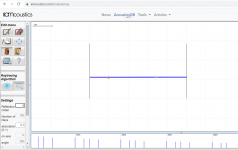
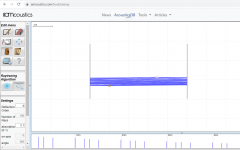
But if we emulate effects of furniture below listeners head by adding attenuation to the sim we see amplitude of the reflections reduce. In reality a sofa the listener sits on would diffract and reflect and attenuate breaking periodicity and reducing flutter even more I think, line of sight between the parallel surfaces is broken. The purpose here is to demonstrate that furniture can intercept the reflections that happen between walls from sound source below listener head without affecting the direct sound.
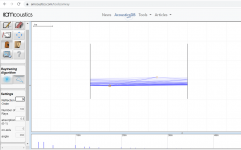
This is fun simulator, floor and ceiling boundaries added in with 9 order reflections includes sound bouncing through multiple boundaries like from floor to ceiling to back wall to ear and so on. Coincidence or not but wall flutter kind of whows up nicely as the source and observer are nearly on same plane and lines bold up, while everything else looks more or less chaotic, reverberation.
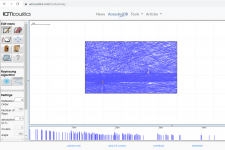
What makes flutter the distinct sound is resonance, periodicity of the distance between the boundaries, and quite many reflections. In a really bad situation the flutter duration is quite long, easily this ~200ms or half a second or even more.
To prevent further clash with it the truth is I haven't studied the flutter much so everyone take this all as something that raises your awareness of it. All you see and read here on my posts is based on imagination and few simple experiments and logic.
there is something lost in translation so I excuse you. I wrote as I mean it and choosing words more carefully would have been justified, to give better context, perhaps leave the line array word out from it as it was kind of unnecessary for the main message. Difference between low standing speaker and line array in the sentence is that the former can be lowered below furniture level if one wants to, while line arrays not so much as they are physically tall. One could start disabling drivers from top of line array to lower the height of the output to get it below furniture level to have the furniture work as acoustic treatment and reduce flutter between walls, as explained. Please do not miss the point that any of this lowering the source is not optimal if the source was designed for ear height and I do not suggest this, its just something one could do if no possibility for acoustic treatment and more clarity is needed and this is the main content of my posts. It would be much better to add/tune the acoustic treatment, what ever the speaker and room was.
Truly? if the sound is nearly full range for any observation height within the height of the array then I've misunderstood line arrays, at least misunderstood how much the sound is beamed, vertical coverage reduced towards highs. I think it would be even worse than I thought for flutter between walls because they would truly blast sound to walls, for the whole height of the array wouldn't they? I thought line array would beam on the center with rising frequency, just like similar sized single transducer would and thats why shading and CBT and what not were evolved from just basic line, to widen the vertical beam. I thought output of individual drivers of array expands spherically and as wavelength gets shorter they combine constructively only on the center axis, which makes loud output there, beaming, or plane in this case assuming horizontal coverage is much wider than vertical. Well, I do not have line arrays so I trust your expertise on them.A line source does not concentrate the sound at the centre, when the observation point is moved up and down within its length it remains quite similar, of course at long lengths there will be some HF difference towards the extremes that is different from the centre.
Here is simplified demo for flutter echo, sound bouncing between two walls, to illustrate the thought process. Two parallel walls, front and back wall, point source loudspeaker on the left, listener on the right, 9 order reflections showing meaning in this 5 meter deep example room a flutter with 9 reflections, or 45 meters of roughly 150ms for easy calculation.
About nothing happens if the source is lowered, if you check out the repetitions they happen about the same time and same intensity. Clapping hands in front, above or below the ears would probably sound about the same if there was only these two walls and their flutter.


But if we emulate effects of furniture below listeners head by adding attenuation to the sim we see amplitude of the reflections reduce. In reality a sofa the listener sits on would diffract and reflect and attenuate breaking periodicity and reducing flutter even more I think, line of sight between the parallel surfaces is broken. The purpose here is to demonstrate that furniture can intercept the reflections that happen between walls from sound source below listener head without affecting the direct sound.

This is fun simulator, floor and ceiling boundaries added in with 9 order reflections includes sound bouncing through multiple boundaries like from floor to ceiling to back wall to ear and so on. Coincidence or not but wall flutter kind of whows up nicely as the source and observer are nearly on same plane and lines bold up, while everything else looks more or less chaotic, reverberation.

What makes flutter the distinct sound is resonance, periodicity of the distance between the boundaries, and quite many reflections. In a really bad situation the flutter duration is quite long, easily this ~200ms or half a second or even more.
To prevent further clash with it the truth is I haven't studied the flutter much so everyone take this all as something that raises your awareness of it. All you see and read here on my posts is based on imagination and few simple experiments and logic.
Last edited:
Lines have very strong vertical directivity! Only extreme nearfield response will be constant.
Here a short line Magnepan LRS. Wesayso can show more drastic examples, from simulations! https://www.audiosciencereview.com/forum/index.php?threads/magnepan-lrs-speaker-review.16068/
https://www.audiosciencereview.com/...-vertical-directivity-mesaurements-png.83606/
My experience tells that lowering ears is more effective than lowering source! Furniture specially sofas will effectively kill horizontal flutter. But at same time vertical mode's phase sum changes, and that might do good or bad.
The Greek study was done in 3 halls, smallest 6x8m. Every hall had quite high level of EDT etc. Typical home rooms are much better and as per my experience, handclaps will reveal only really bad cases. Learning will help for this obviously.
EDT is not always same, here are my MMM of AINOs and Avalanches, 4 measurements per speaker L+R separately for Ainos. One per speaker is from knee level, one above my head. I suppose lowest EDT of mid-high F comes when mic is low. SPL response shows variation too (500ms 1/12), notice that modal frequencies remain same. Avalanches are in the bedroom, I didn't measure below bed level.
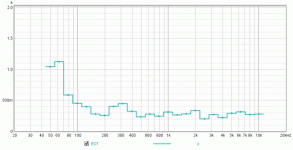
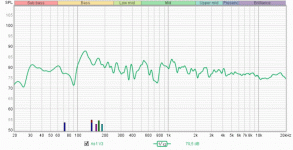
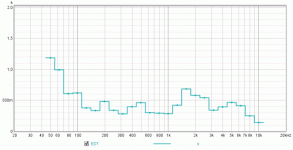
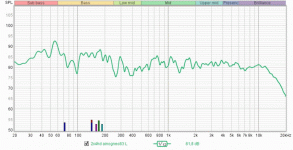
ps. I noticed that modal frequencies are exactly same for both rooms! That's not possible, they seem to come from Room Sim tab's presets!
Here a short line Magnepan LRS. Wesayso can show more drastic examples, from simulations! https://www.audiosciencereview.com/forum/index.php?threads/magnepan-lrs-speaker-review.16068/
https://www.audiosciencereview.com/...-vertical-directivity-mesaurements-png.83606/
My experience tells that lowering ears is more effective than lowering source! Furniture specially sofas will effectively kill horizontal flutter. But at same time vertical mode's phase sum changes, and that might do good or bad.
The Greek study was done in 3 halls, smallest 6x8m. Every hall had quite high level of EDT etc. Typical home rooms are much better and as per my experience, handclaps will reveal only really bad cases. Learning will help for this obviously.
EDT is not always same, here are my MMM of AINOs and Avalanches, 4 measurements per speaker L+R separately for Ainos. One per speaker is from knee level, one above my head. I suppose lowest EDT of mid-high F comes when mic is low. SPL response shows variation too (500ms 1/12), notice that modal frequencies remain same. Avalanches are in the bedroom, I didn't measure below bed level.




ps. I noticed that modal frequencies are exactly same for both rooms! That's not possible, they seem to come from Room Sim tab's presets!
Last edited:
Indeed it is, the exact outcome depends on driver size, length etc. You can sit or stand and have very little difference in sound, if you lie on the floor with your ears below the lowest driver you get nothing but a low rumble of bass.Truly? if the sound is nearly full range for any observation height within the height of the array then I've misunderstood line arrays, at least misunderstood how much the sound is beamed, vertical coverage reduced towards highs. I think it would be even worse than I thought for flutter between walls because they would truly blast sound to walls, for the whole height of the array wouldn't they? I thought line array would beam on the center with rising frequency, just like similar sized single transducer would and thats why shading and CBT and what not were evolved from just basic line, to widen the vertical beam. I thought output of individual drivers of array expands spherically and as wavelength gets shorter they combine constructively only on the center axis, which makes loud output there, beaming, or plane in this case assuming horizontal coverage is much wider than vertical. Well, I do not have line arrays so I trust your expertise on them.
https://www.diyaudio.com/community/...with-shading-in-ath4-horn.391947/post-7171858
The vertical polar is identical between the two observation points, and while the distance isn't very far due to it being a small array, scaling it up would not change the underlying outcome.
But yet in terms of room interaction the result isn't what you would expect.
Without wishing to be a broken record these three things combined are a poor predicator of actual audio reality.All you see and read here on my posts is based on imagination and few simple experiments and logic.
- Home
- Loudspeakers
- Multi-Way
- A 3 way design study
